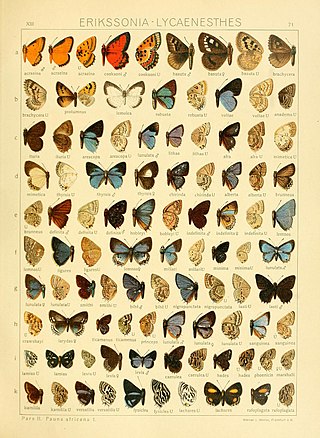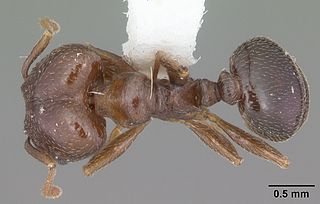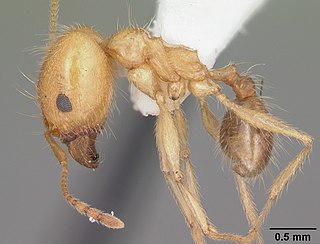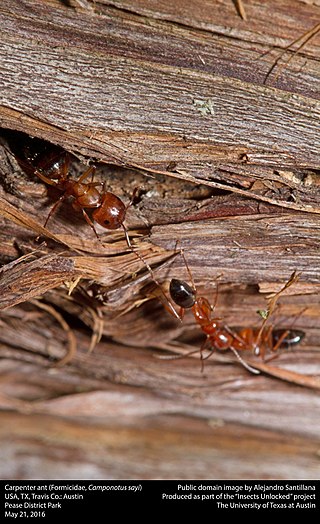
Pheidole is a genus of ants that belongs to the ant subfamily Myrmicinae. The genus is widespread and ecologically dominant. It probably includes more than 1000 species. The genus first evolved in the Americas, eventually spreading across the globe.

Pheidole megacephala is a species of ant in the family Formicidae. It is commonly known as the big-headed ant in the US and the coastal brown ant in Australia. It is a very successful invasive species and is considered a danger to native ants in Australia and other places. It is regarded as one of the world's worst invasive ant species.
Anthene flavomaculatus, the yellow-spot ciliate blue, is a butterfly in the family Lycaenidae. It is found in Nigeria, Cameroon and northern Angola. The habitat consist of forests.

Anthene lunulata, the lunulated hairtail and red-spot ciliate blue, is a butterfly in the family Lycaenidae. It is found in Senegal, Gambia, Mali, Burkina Faso, Guinea, Sierra Leone, Liberia, Ivory Coast, Ghana, Togo, Benin, Nigeria, Cameroon, Sudan, the Democratic Republic of the Congo, Angola, Zambia, Kenya, Zimbabwe, Mozambique and north-eastern Botswana. The habitat consists of savanna and forests.

Anthene lyzanius, the black-patches, is a butterfly in the family Lycaenidae. It is found in Sierra Leone, Liberia, Ivory Coast, Ghana, Nigeria, Cameroon, Gabon, the Republic of the Congo and northern Angola.

Pheidole metallescens is an ant, a species of higher myrmicine in the family Formicidae.

Pheidole vistana is a species of ant and a higher myrmicine in the family Formicidae.

Pheidole moerens is an ant, a species of higher myrmicine in the family Formicidae.

Pheidole rhea is a species of ant and a higher myrmicine in the family Formicidae.

Pheidole tysoni is a species of ant and a higher myrmicine in the family Formicidae.

Pheidole xerophila is a species of ant and a higher myrmicine in the family Formicidae.

Pheidole californica is an ant, a species of higher myrmicine in the family Formicidae.

Pheidole obtusospinosa is a species of ant and a higher myrmicine in the family Formicidae.

Pheidole pilifera is a species of ant and a higher myrmicine in the family Formicidae.

Pheidole hyatti is an ant, a species of higher myrmicine in the family Formicidae.

Pheidole crassicornis is an ant, a species of higher myrmicine in the family Formicidae.

Pheidole morrisii is a species of ant and a higher myrmicine in the family Formicidae.

Camponotus sayi is a species of ant in the family Formicidae.

Pheidole dentigula is an ant, a species of higher myrmicine in the family Formicidae.



















